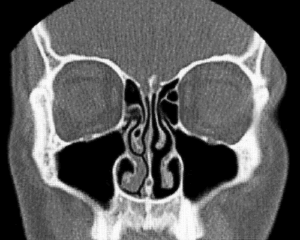
I was puzzled and intrigued to learn about something called “the nasal cycle”. Maybe it will turn out that most of my readers already knew about this, but I certainly did not. It turns out that in all mammals, including humans, there is an autonomic mechanism by which a first nostril’s breathing path constricts for a while and the second nostril’s breathing path remains open. Then after a while the second breathing path is the path that gets constricted and the first breathing path opens up. In most healthy humans, this back-and-forth constriction usually takes place in a cycle of about five hours, with two and a half hours during which one nostril gets preference and another two and a half hours during which the other nostril gets preference. Or, maybe I am just making this up! Could there be such a thing and people would not already know all about it?
Well, no, I am not making this up. There is really this nasal cycle. You, dear reader, are right now mostly breathing through your left nostril or your right nostril, but almost certainly you are not breathing equally right now through both nostrils. Two and a half hours from now, things will be the other way with your two nostrils. And if you are like me, you would be surprised to hear such a thing.
If you are skeptical about whether this is made up or real, I can reassure you, it is on the Internet so it must be true. You can see a Wikipedia article about the nasal cycle here. There are lots of articles on the Internet about it. So yes it must be true.
And this happens in all mammals, or at least it happens in all mammals for which researchers have gone to the trouble of looking to see if it happens.
Why? Nobody knows for sure.
A first theory is that this helps people smell more things better. Some things are easier to smell if the air is moving fast through the nose, past the olfactory organ in the nose. Other things are easier to smell if the air is moving slowly through the nose. (I am guessing those are the more subtle odors.) Anyway what better way to do this than to arrange for the air to move more slowly through one nostril than the other? And of course you would want to go back and forth on this, so that each of your two olfactory organs would get a chance to smell everything at one time or another.
A second theory is that during sleep, this nasal cycle forces you to move around a bit if you are lying on one side for too long. If you are lying on one side, the airflow passage on that side gets crudded up, maybe (to use a technical term) and meanwhile if at that time the other airflow passage is the one that gets constricted as part of the nasal cycle, you would get roused from deep slumber because you are having trouble breathing, and so you would tend to move around to open things up. This way you are less likely to get bedsores or something. I am not making this up — there really are people who think this is why the “nasal cycle” exists.
A third theory is that this permits each side of your nose to get nice and wet during the low-air-flow time, and then when that side’s turn comes around to have normal air flow, the tissues are nice and wet and can help to humidify the inhaled air before it reaches the lungs.
When did this “nasal cycle” first get noticed? I gather that ancient writings about meditation breathing exercises, in what is now India, talked about this nasal cycle. But in the West, it seems nobody noticed it, or at least went to the trouble to write anything down about it, until about 1895.
But even though doctors whose life’s work is to study noses have known all about this since 1895, my impression is that nobody else ever talks about this “nasal cycle” phenomenon.
This “nasal cycle” stuff actually explains a lot about what goes on when a person has a bad cold and their sinuses get congested. I certainly have noticed sometimes when I have a bad cold, that the congestion is really bad on one side for a while, then for a while I really notice it more on the other side, and so on.
Had you heard about this “nasal cycle” before reading this blog article? Please share your answer anonymously here. I will post a followup article summarizing the aggregated anonymous responses of readers.

Hi Carl, everything fine? I’m almost concerned since you have not yet blogged about Belgium joining DAS.
https://www.wipo.int/das/en/participating_offices/details.jsp?id=11660